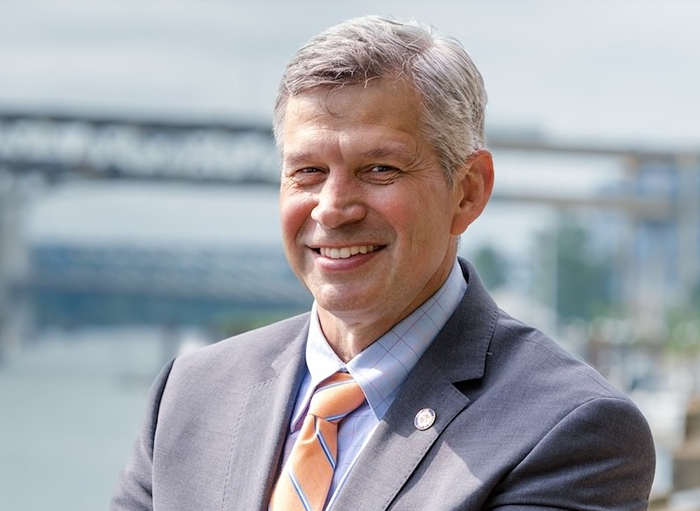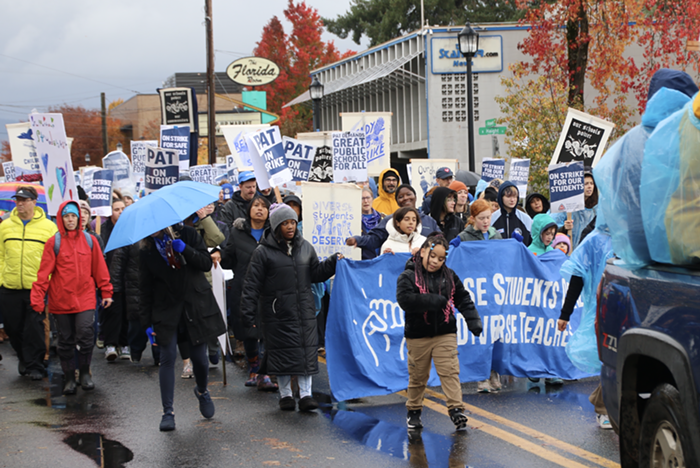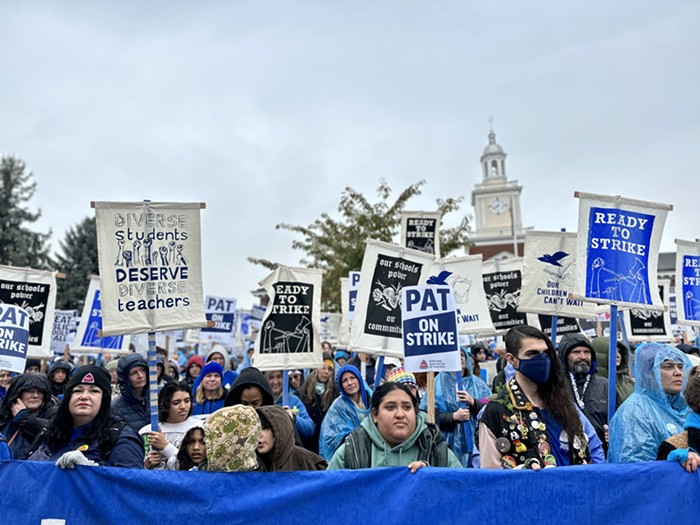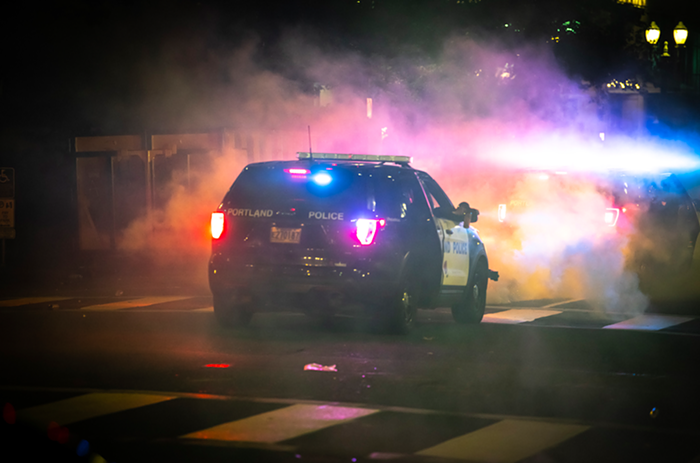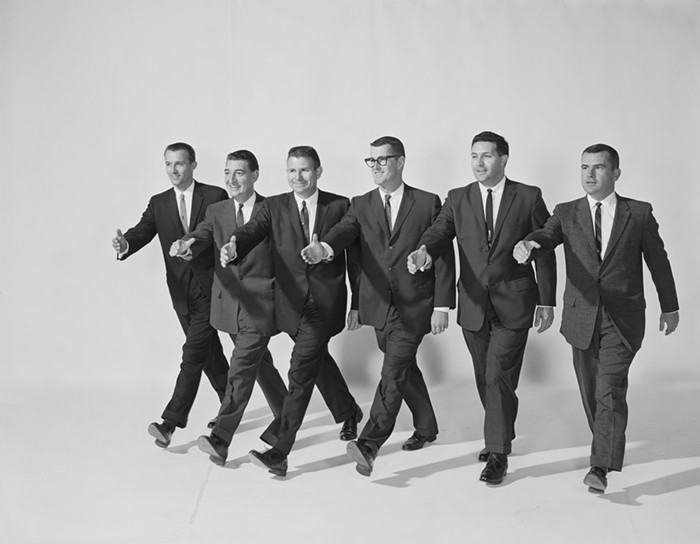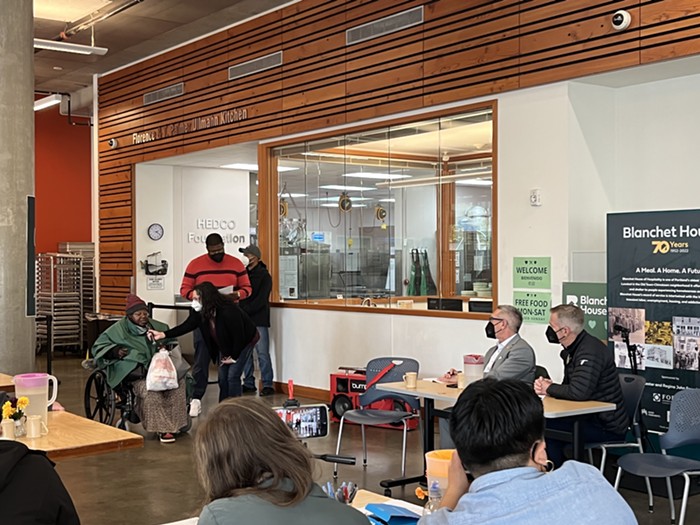"I WENT BECAUSE I WAS TIRED, and I was hurting. I guess that's the difference. I was done," says Vance.
Vance is just one of many names on Portland's "secret list." In short, it's a list of frequent arrestees kept by downtown police, targeted for priority drug treatment. If anyone on this list is busted for regular drug possession in certain areas of Portland—say, if they're carrying a crack pipe in Old Town—it's no longer a misdemeanor. Instead, they are prosecuted with a felony, and given a choice: Either enter drug treatment, or go to jail.
It's been 18 months since the Mercury first learned about Portland's secret list, but as this story goes to press, it's been only two weeks since I first met someone who's actually been through the controversial rehabilitation program.
It's been a long road. First, the city denied the existence of the list altogether—City Commissioner Randy Leonard, who takes credit for spearheading the program, went so far as to write extensively about it on this paper's website last September:
"I have never been told of a list," he wrote. "I have never seen a list, I have never been told by the police bureau there is such a list, and I have never emailed an officer or anyone else about a list."
Leonard insists he was telling the truth at the time.
"When I said I didn't know about a secret list, it's because I didn't know," Leonard says. "I knew they tracked people, but I didn't know it was on a list, and the moment I learned that the list was secret, I asked why. Because it's public information."
It then took a legal fight by the American Civil Liberties Union (ACLU) of Oregon in February to get the city to formally articulate how someone could end up on the list—ACLU partner attorney Elden Rosenthal even compared those running it to the Gestapo.
"The principle at stake is not wanting to collect secret police lists," he said. "Secret police lists have never come to any good, whenever they are used. There's just too much opportunity for abuse."
Bizarrely it was Leonard, not the ACLU, who eventually forced Police Commissioner Dan Saltzman to make the list public at a council hearing on October 21. Saltzman has argued that the people on the list are vulnerable individuals who should be protected from the glare of the media. But ironically, some of these "vulnerable individuals" have been more than happy to talk about the program, while Saltzman declined to be interviewed for this story.
All participants in this article were willing to have their full names printed—but the Mercury has chosen to omit last names to protect their privacy, as well as to avoid any future problems that could be caused for them by the long memory of the internet.
VANCE AND FLOYD
"I've been out here with no shoes on, no shirt, my pants full of shit, down to 120 pounds," says Floyd. "You become what the street turns you into. Aggressive, careless, you take, take, take, and you run, run, run."
Floyd and I are enjoying coffee with Vance at Backspace on NW 5th and Couch on Monday afternoon, October 26. On the short walk over from the Estate Hotel where both men are now in "dry housing," they cast their eyes around for drug dealers.
"If anybody sees us coming over here with you, they'll think you're a mark," Floyd smiles. "And they'll come get your money."
"You best be careful," Vance laughs.
They may be cracking wise now, but until earlier this year, Floyd and Vance were among Old Town's most desperate crack addicts. Floyd has a string of felony convictions going back to 1988—mostly for dealing, but a few for theft and two fairly recently for unlawful possession of a firearm.
"I've been arrested eight times in a day," he shrugs. "For 20 years, I stayed numb."
Floyd does most of the talking. Meanwhile, Vance has a string of misdemeanor theft and cocaine possession convictions on his record, and a couple of felonies for theft and burglary in the '80s and '90s. He also has several convictions for alcohol on public property.
"Me, in a sober frame of mind, I'm not going to walk out and smoke crack," he explains. "You've got to get me drinking first."
I like both men. I first met them five days earlier, at the day treatment center run by Volunteers of America (VOA) in Southeast Portland.
Vance went into rehab on May 12. "I was told nine months before I went that I could go," he says.
"He gave me some burritos and some bread as he was going," says Floyd, as he breaks into another smile. "I sold half of that shit."
Floyd followed Vance into treatment on June 18. They stayed for about three months—actually, Floyd stayed four—in the VOA's new 12-bed residential treatment center on SW 2nd. Both men have been through treatment programs in the past, but this time, it was different, they say.
"A lot of it, to me, was seeing people I'd been out on the street with," says Vance. "I'd say, 'Well shit, I knew how Darryll was when he was out there—he ain't no worse off than I was. This could work for me, too.'"
The 24-hour support offered by the program was vital for Floyd. In previous treatment programs, he says, he would have an "issue" in the middle of the night and have nowhere to turn for help. Both men are about three months from looking for housing for themselves and acknowledge that the road ahead isn't easy.
"But we're both gonna make it," says Floyd. "We are. I networked to get my drugs. I did everything I could to get my dope, and I'm gonna get this too. The same way I went after my dope."
DARRYLL
Darryll is further along than Floyd and Vance. He graduated from the program in December last year, and is now living in Gresham, having once been homeless in Old Town.
"We called ourselves the 12 generals," Darryll says, describing his three months in the residential treatment center with 11 other men. "On the streets we couldn't interact too much because we had to share the money. Now we were all sleeping next to each other—we had to be kind, turn the music down. And we couldn't BS each other because we knew the game."
Now Darryll is facilitating his own rehabilitation groups at the Grove Hotel on W Burnside, and organizing a blanket drive for the homeless at VOA this winter. If he stays arrest free for three years, Darryll's name will fall off the list. At 6 am on Friday, October 23, I followed Darryll around Portland as he opened and cleaned a series of restrooms—the first of which at NW 5th and Glisan is known as "Randy's Loo," Commissioner Leonard's brainchild which was built last year.
Darryll has a job with the downtown Clean & Safe program—a collaborative effort between the Portland Business Alliance (PBA) and social service agency Central City Concern. As he arrives at Randy's Loo, there's a strung-out old homeless couple inside, and Darryll asks them if they "got done with their business." They say "yes," and scurry off. Darryll cleans things up and puts in fresh toilet paper, before getting into his Chevy Astro and heading up to Couch Park in Northwest Portland.
"I used to get high in those bathrooms," he told me, two days earlier, when we met at VOA's day treatment center. "I've been booked more than 100 times, I've got 14 felony drug convictions, just a whole life. They gave me a second chance and I'm grateful for it."
The PBA did not allow me to talk to Darryll while on the job, because they too identified him as "vulnerable," and it's against their policy to allow Clean & Safe employees to be interviewed. But regardless, I decided to observe him on his rounds from a distance, because he works in the public right of way. He appeared to be enjoying himself.
We had scheduled a follow-up meeting on Tuesday, October 27, but Darryll cancelled, sending this text message: "I have been told 2 break all contact with u. I don't want 2 b in the middle of what is going on. Sorry."
The PBA did not confirm or deny by press time whether they gave Darryll these instructions.
Earlier at the VOA, Darryll had told me he can't go back to using.
"I have to ask myself, is it realistic for me to go back?" he said. "When I go down to do the bathrooms, I've been really surprised by the level of respect I've gotten. People say, 'Darryll got a job.'"
THREE OUT OF 77
Floyd, Vance, and Darryll: Their stories are all inspirational. For example, two weeks ago, Floyd went to visit his mother's grave for the first time, having avoided it for three years after her death while he was in the penitentiary.
"I was too embarrassed, too hurt," he says. "I had a lot of shame." Now, he says, he can begin grieving.
This is heady stuff—and as we're talking, I find myself wanting to praise the program from the rooftops. However, overcoming even a run-of-the-mill booze addiction is an emotional experience, fraught with pitfalls. Darryll, Floyd, and Vance say they know of a handful of people who dropped out of the program—and VOA didn't have time to arrange more meetings with others on the list, making it difficult for me to fairly judge the program's success. So I attempted to get some more objective information.
Since February 2008, 77 people have gone through the rehab program associated with the list, says Pam Kelly, division director for rehabilitation service at VOA. Fifty-five have been discharged, 22 are in treatment now, 14 have been re-arrested, and 18 have been re-enrolled. There are currently 359 people on the list, in total.
There wasn't much more statistical information available during the course of researching this article to ascertain the success of the program. And Kelly didn't have any additional information on why those clients had been re-arrested or re-enrolled, or whether the others had left town, or stayed here, and so on.
Indeed, Kelly admits, the city's contract with VOA doesn't require that the success of this program be measured in the same way as its contracts with Multnomah County. For example, the success of another VOA contract with the county's Department of Community Justice is measured by tracking how many clients get arrested before they go through the program and how many afterward. Kelly says partners in this program are due to go on a "facilitated retreat" later in November to begin working out what the "criteria for success" might look like.
"This is a very difficult population," Kelly admits. "So success for these folks might not look the same as it does for other people."
Last year, Leonard and others were touting a "71 percent reduction in recidivism" associated with the program. He says he thinks it's higher now, but the Mercury has seen no clear evidence to back that up−and without it, how are we to know if that figure wasn't essentially meaningless to begin with?
"If Leonard is trusting the police bureau with this 71 percent figure the same way he trusted them that there was no secret list," says Chris O'Connor, a defense attorney who has represented a handful of clients on the list, "then that's a cause for concern."
NO MEASURE OF SUCCESS
The Mercury asked the city to put a dollar amount on the program over the last year. In the fiscal year 2008-2009, the city spent $2.43 million on the program. In 2009-2010, the city has spent $2.55 million—a total of $4.98 million over two years. In addition to housing and treatment, that figure includes $412,000 in police bureau overtime over the same period.
Copwatch activist Dan Handelman has been trying to track the expenditure of tax dollars at council meetings, but has found it difficult because the city has kept changing the name of the program over the last year and a half.
"It's been called the Service Coordination Team, the Neighborhood Livability Crime Enforcement Program, Project 57—the secret list, of course—and the Treatment Priority List," says Handelman. "There are so many names for this program, it makes your head spin. And I think that's been the idea—that you can't nail it down."
City Commissioner Nick Fish has described the program as a "substantial investment of public resources." Indeed, for just $1.2 million, said Fish, voting for the allocation of money to housing for the program on October 21, "we can tackle about 40 percent of the homeless problem on the streets of Portland."
Central City Concern boss Ed Blackburn feels Fish is comparing apples and oranges. "This has a different objective from housing homeless people," he says. "There's a huge cost benefit in terms of the crimes these people are not committing."
Nevertheless, Blackburn says he suggested "two or three times" during the establishment of the program that an independent contractor be brought in to do a cost-benefit analysis, and that he was ignored.
"I'm not necessarily the most influential person with those folks, and I think they were more focused on their own ideas for measuring success," he says. "Now, of course, the question is being raised, and they don't have those statistics."
Dividing the number of people (77) who have gone through rehabilitation on the list into the cost ($4.98 million) equals a total cost of $64,675 per person going through rehabilitation.
"You could have hired a ton of social workers for that money," says O'Connor. "You could have paid for a social worker to stand on every corner of the city for a year. It's one thing if the police want to be social workers—but should we really be paying them police overtime wages to do that?"
Leonard, like Blackburn, says the program is worthwhile because of the damage the worst offenders can cause to the community.
City Auditor LaVonne Griffin-Valade says the city has no immediate plans to audit the program—at least until its next reassessment of auditing priorities next spring. She doesn't feel qualified to comment directly on the program without knowing more about it, but says, "We would hope that when any bureau is trying to establish a new program, they will determine how to track outcomes, and then how to measure those outcomes for success.
"That's just basic good management practice," Griffin-Valade continues.
The program has also been ramped up after the demise of the city's controversial Drug-Free Zones (DFZ) in late 2007, after the DFZs were caught overwhelmingly targeting African Americans, says Copwatch's Handelman.
"I think the people behind the new program are hoping it won't attract the same level of scrutiny as the DFZs," he says.
However, when the Mercury first saw a leaked copy of the secret list in April 2008 ["Blacklisted," News, April 24, 2008], 52 percent of the people listed were African American, while comprising just 6 percent of the population. Today, that number has only dropped to 50 percent.
"I do support treatment," says Reverend Doctor LeRoy Haynes from the Albina Ministerial Alliance. "But at the same time we want to make sure that African Americans who are homeless or addicted are not being abused by law enforcement."
Haynes adds that city council has always expressed a wish for transparency around the police bureau, in the past. Commissioner Leonard says he would now support more statistical information being made publicly available about the program, "as long as it's not redundant."
"They don't always connect the dots on the politics," says Leonard, referring to Officer Jeff Myers and Bill Sinnott, the managers of the program at the police bureau. "They can sometimes be their own worst enemy by looking like they don't want to share information—but I don't think they're intentionally hiding anything."
Both Myers and Sinnott declined to be interviewed for this story and did not return repeated emails seeking comment.
CLUMSY OR CALCULATED?
It's difficult to tell whether the city's elusive answers to questions about this program over the past 18 months have been the result of calculation, defensiveness, clumsiness, or a combination of the three. Either way, Handelman says he now wants a thorough public debate about the merits of the program, its expense, and whether it might be cheaper to pursue alternatives.
"Ten years ago if you were a desperate addict, you could get 90 days of inpatient treatment just by asking for it," says Jason Renaud with the Mental Health Association of Portland—who ran the Estate Hotel for Central City Concern for three years in the early '90s. "The people on this list would have gotten access to treatment without having to go through the criminal justice system first."
Since then, says Renaud, state and federal funds to provide rehabilitation services at a local level have been lost and the police are left to fill in the gap.
"They're just trying to make this work in their own clumsy way," he says.
Being included on the list, Vance does express concern about being given a felony before he could enter treatment. But Vance, Floyd, and Darryll are largely unconcerned by many of the problems associated with the program in the eyes of its critics.
"Maybe the white guy in the bar selling cocaine is just using his brain a little bit more than I am," says Vance. "At the end of the day what I see from the guys that are in charge of this is a 'give and take.' You can't imagine the amount of crime that's not happening right now because of this program."
Floyd is more succinct.
"When I look at all the money the government wastes on bullshit," he says, "it's still worth it, even if you only save two people."
You can donate to Darryll's blanket drive at Volunteers of America (537 SE Alder). If you would like to see the city auditor take a closer look at the program next year, email your concerns to her office representative at andrew.bryans@ci.portland.or.us.


